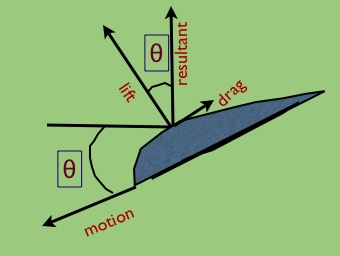|
|
|
Gliding :
Gliding occurs when the resultant
force, R, of the lift (L) and the drag (D), is exactly vertical,
thus balancing the gravitational pull.

The glide ratio
is the same as the lift to drag ratio.
(Adapted from Alexander, D. E, 2002.
Nature's Flyers)
R,
makes angle with L. Hence,
tan θ = D/L
The glide
ratio is defined as the ratio of horizontal distance covered to
the vertical distance covered.
Hence, glide ratio = cot θ = L/D
A higher aspect ratio indicates higher value of L/D, thus, a smaller θ.
This implies, that,
birds with a high aspect ratio can tilt a little bit, and start to
glide.
As they do so, they
also cover a longer horizontal distance as compared to others with
lower aspect ratios.
Some interesting values for aspect
ratio and the corresponding L/D ratio are as follows:
Flyer
|
Aspect
Ratio
|
Ratio
of Lift to Drag
|
Fruit
Fly
|
5.5
|
1.8
|
Bumble
bee
|
6.7
|
2.5
|
Sparrow
|
5.3
|
4.0
|
Swift
|
11.0
|
10
|
Albatross
|
15.0
|
19
|
(Adapted from Alexander, D. E, 2002.
Nature's Flyers)
As R balances
weight in case of gliding, the speed remains constant, but the motion
is generally directed downward.
Soaring :
Soaring occurs when a bird glides
but maintains a constant height,
or, actually, increases its height! Hence, it does not flap its
wings but continues to rise. This can happen, for instance, if the bird
glides through a region of rising air. Then, if its downward speed due
to gliding is smaller than or equal to the speed of the rising air,
soaring takes place.
Web Project by Debasmita Samaddar
PHYS 645, University of Alaska
Fairbanks
Fall - 2007
source for template
-> Free web templates
|
|



